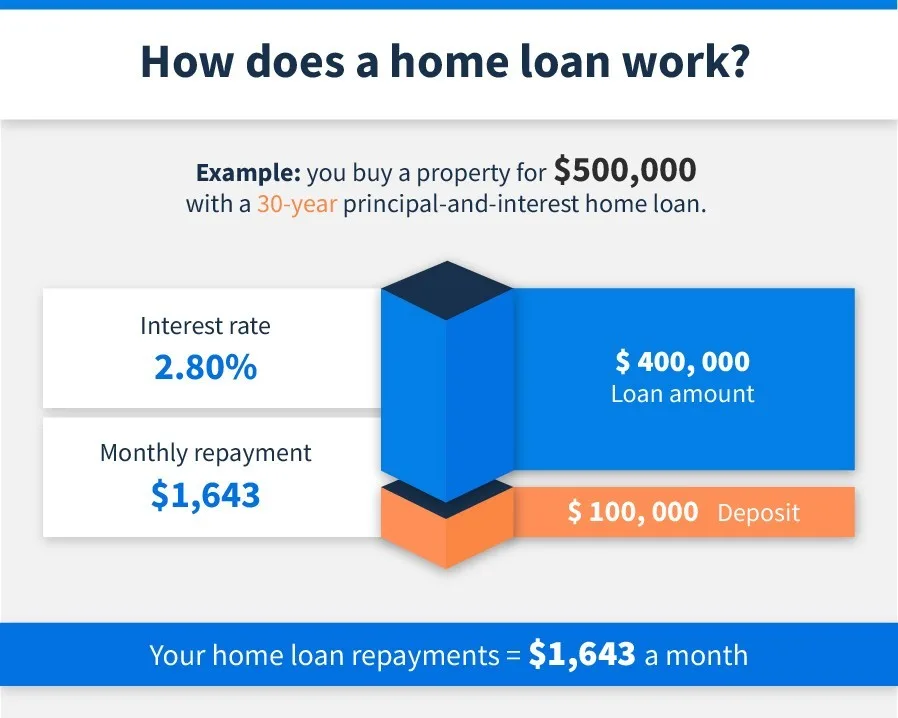
First homebuyer e-course
Sign up for our FREE 8-week course to get on the property ladder.
A home loan, also known as a mortgage, is the money you borrow from a bank or lender to purchase a home or investment property.
When you borrow funds from a lender, you then repay the amount according to a loan repayment schedule and the lender charges you interest.
The money you borrow is called the loan principal. The interest your lender charges you is determined by the home loan's interest rate.
To fully understand what a home loan is and how it works, we need to look at some key components of a loan:
Australians typically borrow between 80% and 90% of a property's value, which means you need to save or gather together a deposit worth 10–20% of the property's value. The difference between the loan amount and your property's value is the deposit that you must pay. The percentage of your home's value compared to your loan amount is known as your loan to value ratio (LVR).
For example, if you want to buy a home worth $700,000, you'll need to save $70,000 in order to have a 10% deposit. Or you could save $140,000 for a 20% deposit, which will allow you to take out an 80% loan.
The benefit of an 80% loan is that you won't need to pay Lenders Mortgage Insurance (LMI).
A typical loan term for Australian home loans is 30 years, although you may be able to arrange a loan term of between 25 and 40 years. It may be possible to work with your bank or lender to choose a different length loan term, and with some loans you are able to make extra repayments to pay your home off faster.

The interest rate is the most important part of a home loan. It determines how much interest you end up paying.
The lower the interest rate, the cheaper your loan will be. Here's a simple example:
If the rate fell to 2.24%, your monthly repayments would be $1,908. That would save you $26 a month or $312 a year.
Your interest rate will either be a fixed or variable rate.
Loans with variable interest rates can change at any time and typically offer more flexibility than fixed rates. There are no breaking costs associated with refinancing a variable rate loan, and these loans are more likely to come with features like extra repayments and offset accounts.
With a fixed rate loan you can lock in a specific interest rate for a period of time, typically between 1 and 5 years. This means you will know exactly what your repayments will be each month, because the rate won't change for the fixed period.
If your bank or lender increases their variable rate loans, your repayments won't be affected. This applies whether interest rates rise or fall.
This really depends on your needs as a borrower. Variable rate home loans are more suitable for those who wish to pay off their home loan as quickly as they can, as extra repayments allow you to make more headway with your loan principal.
Fixed rate loans are less likely to come with offset accounts or allow unlimited extra repayments. And if you want to refinance a fixed rate loan during the fixed period, there is a fixed loan break cost to consider.
Another decision you'll have to make is your loan's repayment type. You have 2 options:
For investors looking to maximise their tax position, interest only investment loans make sense, because interest costs are tax deductible for investors. This means that the entire mortgage repayment is just interest (no principal) and the whole amount can be claimed against your tax. This can help to keep mortgage costs down for landlords.
Some owner occupiers choose to make interest-only repayments when they're having trouble covering repayments due to job loss or increased expenses, or perhaps because of a short-term financial change, such as being on maternity leave.
Here's an example of the difference between the 2 repayment types:
| Details | Principal and interest | Interest only |
|---|---|---|
| Loan amount | $400,000 | $400,000 |
| Loan term | 30 years | 30 years |
| Interest rate | 2.80% | 2.80% |
| Interest only period | N/A | 3 years |
| Monthly repayments | $1,644 | $933 (during interest only period) $1,761 (after interest only period) |
| Total loan cost over 30 years | $591,688 | $604,117 |
| Difference in overall cost | $12,429 cheaper | $12,429 more expensive |
The reason you need the home loan is going to determine the type of home loan you can apply for. If you're borrowing money to buy a home to live in you'll need an owner-occupier mortgage. If you're buying an investment property, you're looking for an investment loan.
Owner-occupier loans usually have lower interest rates than investment loans. In most other respects they're similar.
Home loans come with different features, which can make a big difference to how you can use them.
Many variable rate home loans allow you to make additional repayments in order to pay down your home loan faster. This can add up to a massive savings in interest payments over the life of your loan. Have a look at the calculator below to see how extra repayments can impact the total amount you pay for a home loan.
Offset accounts are transaction accounts attached to your home loan. Any funds in the account are used to offset the interest you're charged. For example, if you place $10,000 in your offset account, and you have a loan amount of $350,000, your interest will be calculated on a loan amount of $340,000 rather than $350,000. Offset accounts usually give you complete access to your funds like any other transaction account. As with the extra repayments mentioned above, offset accounts can help you save a significant amount over the life of your loan. Check out our calculator to see how an offset account can save you money.
A redraw facility allows you to borrow any extra money you've already repaid on your home loan. This can be a useful tool to access in emergencies, or if you're looking to carry out renovations.
This type of home loan allows you to split your loan into a variable rate portion and fixed rate portion. A split facility is not a type of loan in itself, but a feature offered by lenders on some home loan products.
A low doc home loan can help self-employed borrowers who don't have some of the documentation typically required by lenders. To find out if a low doc home loan might be the best option for you, read our guide.
If you're looking to build your home, you'll need a special type of loan known as a construction home loan. These loans can also help if you're looking to make major renovations to your existing home. Head here for an in-depth discussion of construction loans.
A line of credit, or home equity loan, allows you to borrow against the equity of your home. Equity is the difference between what your house is worth and how much money you owe on it. For instance, if your house is worth $500,000 and your mortgage is $250,000, you would have $250,000 in equity.
A reverse mortgage allows borrowers aged 60 or above to convert the equity in their home into cash which they can use to fund retirement, aged care or purchases. This home loan does not require ongoing repayments, but is instead repaid when the borrower sells their home. For more information, check out our explainer on reverse mortgages.
Once you've compared home loans and found a suitable one, it's time to apply for the loan.
You can submit a full application if you have a property you want to buy and a signed contract. But you can start the process before that by getting pre-approval.
Pre-approval is like submitting a partial loan application. The lender gets some basic information from you, and provides you with a rough idea of what you could borrow from them. It's not a full approval, but it's a good start.
Whenever you do submit a full application you'll need some documents.
Your lender will process your paperwork and conduct a credit check. Then it will send out all your loan documents for you to sign and return. This process will take about 7-10 days.
Anywhere from 1 to 2 weeks after the loan documents have been signed and returned, your loan will settle, meaning the funds are released to the vendor of the property you're purchasing, and the title of the property is transferred to you.
The Homebuyer Fund allows Victorians to buy homes with 5% deposits in exchange for a share of the property.
Chris Gray takes us through four things people get wrong when buying property.
Auction expert Damien Cooley gives the lowdown on why property auctions are the best way to sell right now.
Richard Holden from UNSW Business School delves into Australian home loan sizes and rate cuts
We can't make clear predictions about Sydney's property market, but here's what the data suggests.
There's profit to be made in renovating your home, but don't jeopardise your insurance when you do.
The Freedom Lend Fixed Rate Home Loan combines a competitive fixed interest rate with no ongoing monthly or annual fees.
Australians are now drinking less than we previously were. Find out how you could save $40,000 by simply not drinking alcohol.
Compare current bank interest rates for home loans, credit cards, personal loans, savings accounts and term deposits to find the best deal for you.
What is an offset account? It can save you thousands in interest and help you own your home sooner.

Sign up for our FREE 8-week course to get on the property ladder.

Get a home loan with a low deposit.

Pay less for your home loan with a super-low interest rate.

Save on your investment loan with these hot offers.